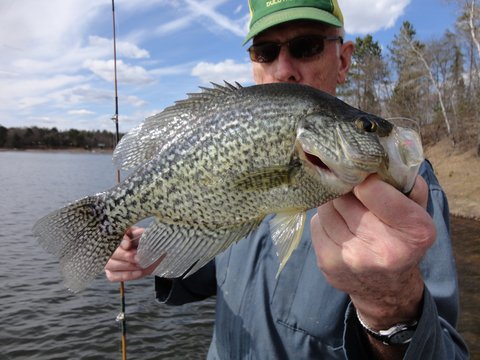Crappies are a favorite for many anglers when it comes to ice fishing because they are prevalent and fairly easy to catch throughout the winter season. Yet even the most seasoned crappie anglers can take more fish this winter if they learn the crappie color basics.
Crappies have exceptional sight, so color is especially important when it comes to the baits they will pursue.
The first thing to remember about color is that it is highly affected by light. Typically, shallow water has more light, and the deeper you fish, the less light is available. To catch crappies with color, you need to imagine what the fish are seeing.
Think about the first 10 feet of water below the ice. It has the most light during the daytime hours. Dark jigs in black or brown will be easy to see against the light filtering through the ice. But in this shallow water, the crappies will also be able to see bright colors like pink or orange. In this situation a dark jig, tipped with a bright color will be especially effective.
As you fish deeper, in say 10-15 feet of water, the light is reduced significantly and you will lose the contrast factor with the light filtering in through the ice. In this depth range, brighter colors become more of a factor. Try jigs in orange, chartreuse, yellow and white. They will be highly visible to the crappies and are more likely to draw them in. At this depth, light colors reflect light fairly well, and the lighter the color, the more light it will reflect. This means that white jigs will reflect the most light, so they are highly effective in this depth range.
Deeper still, as you go beyond 15 feet, there is very little light available. The neon colors will no longer be visible to the crappies. Although it may seem odd, the best colors in the low-light conditions of deep water are the dark colors. Black, brown, purple, green and yellow will work well, but the color that is the most visible is blue. Try a blue jig body with a contrasting head in yellow or green.
As you take light and color into consideration, you must also factor in the conditions above the ice. A heavy snow pack reduces the amount of light getting through the ice. Conversely, if there is no snow on the ice, more light will be getting through. You will have to adjust your depth range a bit, depending on these factors.
And of course, if you are fishing at night, there is no light getting through, so the deep water colors will be your best choice at any depth.
Understanding colors and how crappies see them at different depths will significantly improve your success this winter. Make sure to carry wide range of colors of both jig heads and bodies, so you can experiment with color combinations.
Photo credit: Dreamstime








